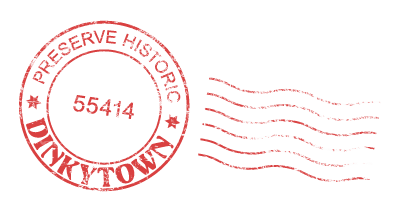Literary Roots of Dinkytown
Minnesota is one of the largest contenders in the national literary scene—second only to New York in the number of small press publishers per capita. We host one of the largest Book Festivals in the country and generate award winning writers in every genre including playwriting and poetry.
The Open Book Center is unique in North America and The Loft Literary Center, housed there, is recognized as the most exciting teaching and writing center in the nation. Dinkytown provided the root stock and planting soil for these developments—a particular literary blossoming that now benefits the entire state.
Because of the presence of used and new and rare book stores in the ’50s,’60s and ‘70s, readers and writers felt at home in Dinkytown, made it a destination, and relied on the engine of its production system to establish and further their careers. Readings of internationally renowned writers at the original Loft on 4th Street (Ginsberg, Snyder, Bly) inspired local writers and set the standard for excellence that continues to buoy the state literary economy.
All of this activity came about because of a unique quality of place generated by the combination of small independently owned bookstores, coffee shops with invested long-term purveyors, sidewalks that permitted slow walking and talking, University proximity with professors holding classes in Dinkytown establishments, and the welcome presence of remarkable street characters who fostered an intellectual exchange outside of academia.
THE LOFT LITERARY CENTER
1302 S.E. 4TH STREET
We want a historical plaque. – Jocelyn Hale, Director of The Loft, 2014
Marly Rusoff
The Loft Literary Center was founded in 1974 in a loft above Marly Rusoff’s Dinkytown bookstore (Rusoff & Co. Book Dealers) by a group of writers who were looking for a place to meet. Some of the early writers and poets who met and read to a growing audience were Robert Bly, James Moore, Patricia Hampl, Phebe Hanson, and Michael Dennis Brown.
As its membership and activities grew, The Loft moved from its birthplace in Dinkytown to larger spaces and in early 2000 moved into its present home, The Open Book. By 2006, The Loft’s web site could state that it was the "nation's largest and most comprehensive literary center, offering programs and services for readers and writers."
Perfectly located near an institution of higher learning, it offered a counterculture in the finest sense, something that must remain if we want a world that celebrates creativity and open minds. – Marly Rusoff, December 2014
The list of acclaimed authors who have appeared at The Loft over the years reads like a Who’s Who of American Letters. Many local authors taught, read, and established or furthered their book careers through Rusoff’s patronage at her S.E. 4th Street bookstore. The bookstore itself had extensive holdings of new books and magazines and was particularly noted for its small press and little magazines.
On April 17, 2005, the Kay Sexton Award, honoring an individual or organization involved in fostering books, reading, and literary activity in Minnesota, was given to Rusoff by the Minnesota Humanities Commission. Rusoff, who has lived in New York since 1982, is currently a literary agent, former publishing executive, and creator of the first Reading Group Guide (for Margaret Atwood's The Robber’s Bride) for book groups.
❦ LEARN MORE: The Loft Literary Center - Loft History
BOOKSTORES
Dinkytown is a destination for book hunters. For decades many important new and used bookstores catered to general interest readers, children, professors, students, obsessive students of arcana, scholars, and rare book collectors.
This book haven has been a critical part of Minnesota’s eventual rise to the top in the nation as a home for independent bookstores, presses, and fine press publishers.
Everyone from the University and surrounding neighborhoods spent time in Dinkytown in earlier eras. Here is a short list of the accomplished WRITERS and POETS—local, national, and international—who milled the streets between the University and Dinkytown’s bookstores, bought books, or read from their own works there. The historic map on the previous page shows Dinkytown before The Book House was relocated in 2013.
A map and timeline of Dinkytown’s historic bookstores is in progress. See Lost Bookstores of the Twin Cities, compiled from bookmark collections.
MCCOSH’S BOOK STORE
1404 4TH ST. S.E.
The legendary Melvin McCosh started his bookstore in the ground floor of his house, at the northeast corner of 5th Street and 14th Avenue. He had thousands upon thousands of books and rented out rooms to well-known Dinkytown characters such as Marv Davidov and John Shevlin. Around 1958, he opened McCosh’s Books, adjacent to what was then Bridgeman’s and is now Potbelly on 4th Street S.E. McCosh and John Heddan, whose bookstore was on 14th Avenue, used to buy books together, using an old panel truck, which they shared.
McCosh’s eviction, to make way for a new kitchen for Bridgeman’s, created a ‘sit in’ protest movement at Bridgeman's. He bought an old firehouse, now the Mixed Blood Theater, and moved his store to the West Bank. After a brief stint in an old schoolhouse in Dundas near Northfield, he moved to a former retirement home for Swedish Lodge members in Excelsior.
Each summer he would send out flyers from the 42-room mansion, exhorting readers about the upcoming sale, “You need these books more than I do.” He returned to Dinkytown in 1989 to build bookcases for the Book House during Dinkytown’s expansion.
PERINE’S CAMPUS BOOK STORE
315 14TH AVE. S.E.
Perine’s was a fixture in Dinkytown for over three-quarters of a century. Dinkytown’s history is written on its buildings, and in its historic murals. Overlooking the train tracks, it is a gateway to Dinkytown.
Perine’s sold not only new and used textbooks, but a panoply of general books including literature, philosophy, history and science. It was known for its imported foreign language books and was the place to go to buy the American Library editions of Proust’s Remembrance of Things Past or Gurdjieff’s Meetings with Remarkable Men. Faculty provided their class booklists well in advance of the next quarter and students who wanted to delve into learning areas beyond the classroom perused the bookshelves.
It was closed in the 1970s and is now Annie’s Parlor and The Kitty Kat Klub.
THE PAUL ROBESON BOOKSHOP
13TH AVENUE S.E.
HEDDAN BOOK STORE
413 14TH AVENUE S.E.
The Paul Robeson Bookshop was initially located in an old house on 13th Avenue S.E. between 4th and 5th Streets S.E. It was the home of Marxist books and periodicals. Heddan’s was a used bookstore located at 413 14th Avenue S.E., housing mountains of hard-to-find books. John Heddan and Melvin McCosh, both Dinkytown bookstore owners, bought books together and went on foraging expeditions together to locate materials such as bricks and streetcar tracks for shelving.
The Book House
1316 4th St. SE
The Book House was founded in 1976 by two bookseller couples, whose main business had been selling academic books and collections to libraries: James and Kristen Cummings, and Dr. Rob and Lynn Wozniak.
In the mid ’70s, library budgets had been slashed, McCosh’s book store was gone, and Dinkytown Antiquarian Books had opened on the second floor of Dinkydale as a collective of five book dealers. Soon Wozniak and Cummings decided to set up shop together, teaming up Wozniak’s basement collection of thousands of academic books and Cumming’s 60,000+ books that hailed from personal collections in Stillwater and Jim’s antiquarian bookshop in Wayzata.
By the late 1980s, after Wozniak’s move to Philadelphia and a store expansion, the store housed well over 120,000 books crammed (two deep) into 3,000 square feet.
The ‘Old Book House’ (1976- 2013) was notorious for its ‘depth of stock': customers exhausted the long late hours working up and down the books in-all-fields that piled in the well-worn stairway and lined the store’s labyrinthine floors.
In 1994, Book House was one of the first large stocks in the country to go online. Hundreds of volumes and customers flowed through the Book House doors every week and innumerable collections, both distinguished and commonplace, found homes. The customer base was so broad that the Book House, it seemed, could sell just about any kind of print.
Journals and Reviews in Dinkytown
Supporting the interest in books and readings were the literary reviews that circulated around Dinkytown during the 1960s to 1970s. Students hung out in restaurants and coffee houses reading and discussing these reviews, which usually came out quarterly, semiannually, or annually. In addition, a number of literary pieces were published in odd corners and rooming houses of Dinkytown. McCosh’s Bookstore issued several publications.
The Dinkytown News stand at the corner of University and 14th Avenues was a center point of distribution for every kind of media, including international papers, and literary and socialist journals of the times. The news stand was a first stop before coffee or lunch at Gray’s counter, Bridgeman’s, or the coffee house. It changed hands and later, due to pressures, moved to the Al Johnson’s building across from Gray’s Drug (now the Loring Pasta Bar).
By the late 1990s, “Dinkytown News” was represented only by a well-loved one-armed vendor with a corner stand on the NW corner of 4th Street and 14th Avenue.
In the early 1970s, Savran’s Book Store on the West Bank, and Rusoff & Co. Book Dealers in Dinkytown kept the University area well supplied with the literary arts and journals. Don Olson was a familiar face, as the area’s long time distributor of local printed matter, literary and political rags of all kinds.
THE MINNESOTA REVIEW
The Minnesota Review, a journal of creative and critical writing, was established in Minnesota in 1960. Although some of the early editors were from Macalester College, early issues have a disclaimer against affiliation with any university, and the magazine was distributed from Dinkytown.
The magazine was oriented toward publishing avant garde fiction, poetry, and graphic work. Early editors were Sarah Foster and Neil Myers (early 1960s), Roy Arthur Swanson (mid 1960s) and Alvin Greenberg (1967-1973).
The magazine is still being published under the name The Minnesota Review, but now it originates from Duke University.
NICKEL & DIME QUARTERLY
Lewis Hyde’s Nickel & Dime Quarterly was published in the 1960s. Hyde is a nationally renowned scholar, essayist, translator, cultural critic and writer, who was named one of the most influential writers of his generation.
He attended the University of Minnesota in the early 1960s, benefiting enormously from his relationships with John Berryman and Robert Bly, as well as Garrison Keillor, then the editor of the Ivory Tower, who was the first person to take Hyde’s poetic efforts seriously and who published Hyde’s earliest nonfiction.
SING HEAVENLY MUSE! WOMEN’S POETRY AND PROSE
PUBLISHED AT 509 15TH AVE. S.E. MINNEAPOLIS
Collection held at the Minnesota Historical Society Library and Archives
“…very few women were being published. Women’s voices needed to be heard. So I decided to publish a small press journal of that lasted over twenty issues. Of course, the blooming of the publication of women writers was part of the women’s movement in the 1970s.”
THE NORTH STONE REVIEW
The North Stone Review, founded and edited by James Naiden, began publication in 1971 and continued until 2002. The magazine included short stories, poetry, essays, short plays, reviews, and drawings. Naiden also edited Caesura: A Literature Newsletter, a 1974 publication of the Minnesota State Arts Council, which was distributed from University Station in Dinkytown. The newsletter included listings of readings, many occurring at The Loft at Rusoff’s bookstore.
Naiden lived and still lives in Dinkytown.
THE IVORY TOWER
The Ivory Tower was a publication of The Minnesota Daily at the University of Minnesota, and was published every Monday beginning in 1953.
At its inception, it provided a more literary satirical slant on the news. By 1958 it included short stories, poetry, and essays. Dick Guindon’s “Hugger Mugger” cartoons were one of the most anticipated aspects of the magazine.
Alumni of The Ivory Tower include former editor Garrison Keillor; former associate editor Patricia Hampl, author and University of Minnesota English Professor; and editor Peter Stitt, a recognized James Wright scholar.
The Ivory Tower has recently been resurrected by the English Department, which has researched issues from 1953 through 1969 to use a model for the new version of the magazine.
LITTLE SANDY REVIEW
The Little Sandy Review was a mimeographed Twin Cities rag about folk music published from 1960 to 1968. by Paul Nelson and John Pankake. It was the first source to reveal that Zimmerman had invented Dylan. It has been written of The Little Sandy Review that it "...was first to invent, essentially from scratch, the foundations of modern rock journalism." (David Lightbourne in The New Vulgate #4, July 29, 2009).
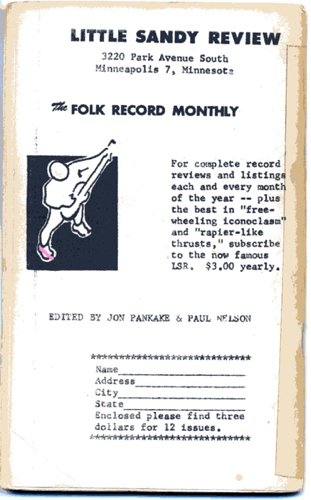

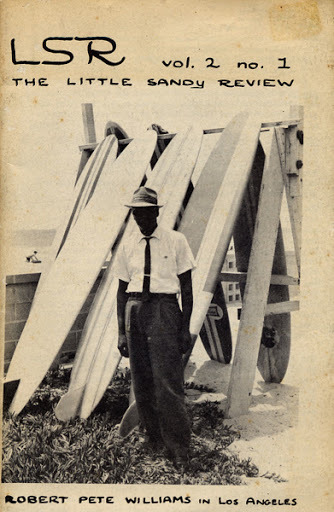
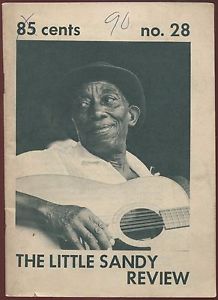

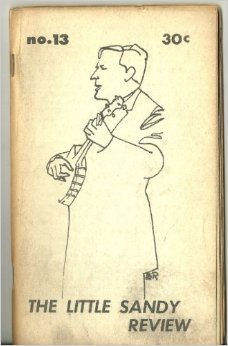
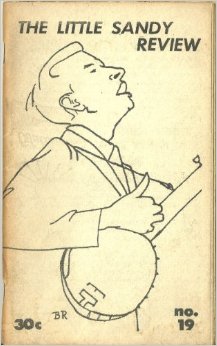
NOTABLE LITERARY FIGURES OF DINKYTOWN
Fredrick Manfred, Jack Ludwig, Saul Bellow, Robert Penn Warren, John Berryman, Allen Tate, James Wright, Robert Bly Carol Bly, Michael Dennis Browne, Patricia Hampl, Freya Manfred, James Moore, Erik Storlie, Phebe Hanson, Nor Hall, Lewis Hyde, Judith Healey, Joe & Nancy Paddock, Garrison Keillor, Gary Snyder, Allen Ginsberg
